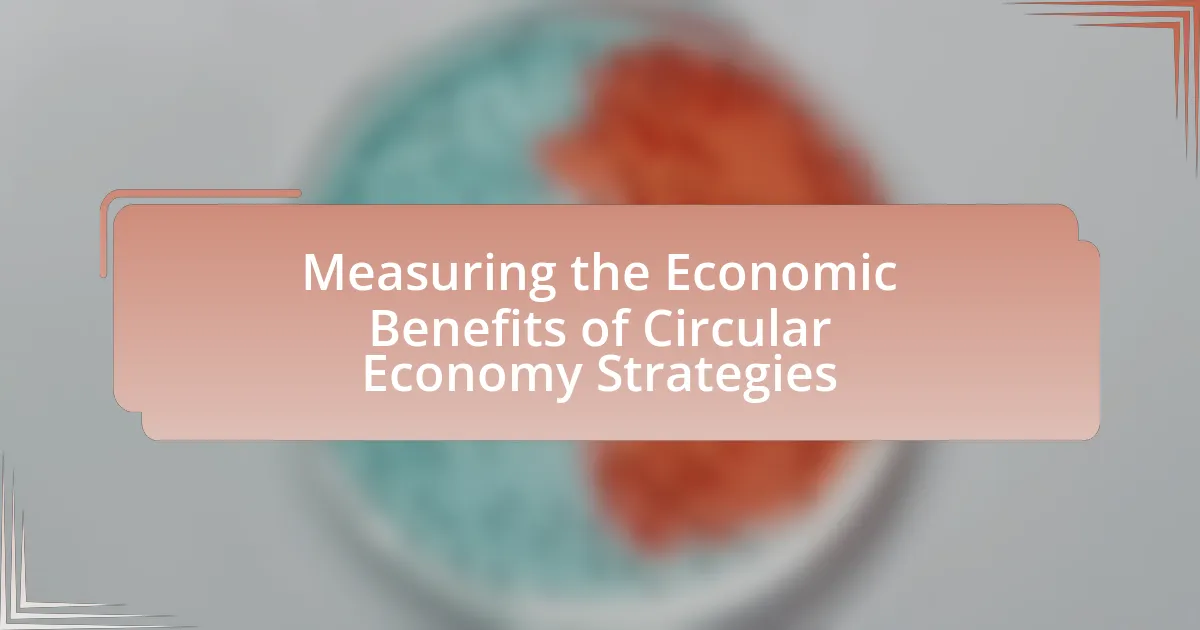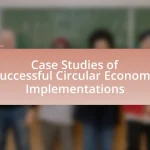The article focuses on measuring the economic benefits of circular economy strategies, which aim to minimize waste and maximize resource use through practices such as recycling, reusing, and remanufacturing. It contrasts these strategies with traditional linear economic models, emphasizing principles like waste reduction and resource efficiency. Key components include product lifecycle management and sustainable business models, while the article also addresses challenges in quantifying economic impacts, such as data availability and the need for standardized metrics. Additionally, it outlines best practices for organizations to enhance measurement accuracy and the significance of collaboration among stakeholders in improving measurement efforts.
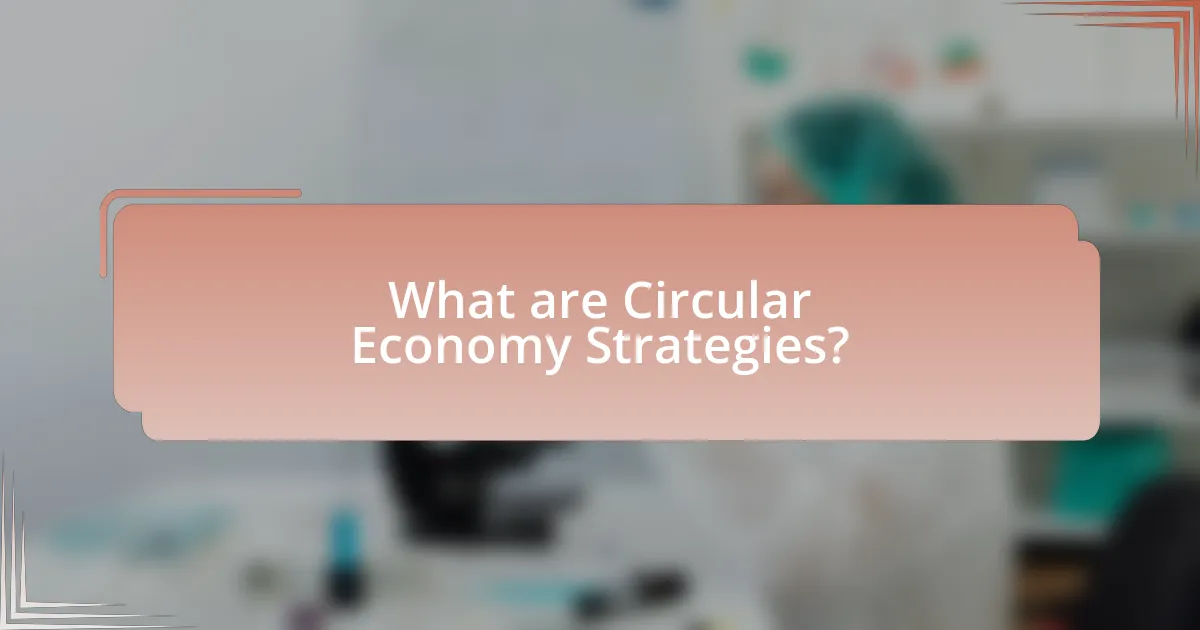
What are Circular Economy Strategies?
Circular economy strategies are approaches aimed at minimizing waste and making the most of resources by promoting the continual use of products, materials, and resources. These strategies include practices such as recycling, reusing, remanufacturing, and designing products for longevity, which collectively contribute to reducing environmental impact and enhancing economic efficiency. For instance, a report by the Ellen MacArthur Foundation highlights that transitioning to a circular economy could generate $4.5 trillion in economic benefits by 2030, demonstrating the potential financial advantages of implementing these strategies.
How do Circular Economy Strategies differ from traditional economic models?
Circular Economy Strategies focus on resource efficiency and sustainability, contrasting with traditional economic models that prioritize linear consumption and waste generation. In a circular economy, products are designed for longevity, reuse, and recycling, which minimizes resource extraction and environmental impact. Traditional models typically follow a “take-make-dispose” approach, leading to increased waste and depletion of natural resources. For instance, the Ellen MacArthur Foundation reports that transitioning to a circular economy could generate $4.5 trillion in economic benefits by 2030, highlighting the potential for significant economic gains through sustainable practices.
What principles underpin Circular Economy Strategies?
Circular Economy Strategies are underpinned by principles such as waste reduction, resource efficiency, and product lifecycle extension. These principles aim to minimize environmental impact by promoting the reuse, recycling, and regeneration of materials. For instance, the Ellen MacArthur Foundation emphasizes that a circular economy seeks to design out waste and pollution, keep products and materials in use, and regenerate natural systems. This approach not only conserves resources but also creates economic opportunities, as evidenced by a report from Accenture which estimates that transitioning to a circular economy could generate $4.5 trillion in economic benefits by 2030.
Why is the transition to a Circular Economy important?
The transition to a Circular Economy is important because it promotes sustainable resource use and minimizes waste, leading to economic benefits. By shifting from a linear model of production and consumption to a circular model, businesses can reduce costs associated with raw materials and waste management. For instance, the Ellen MacArthur Foundation reports that transitioning to a Circular Economy could generate $4.5 trillion in economic benefits by 2030 through increased resource efficiency and innovation. This model not only conserves natural resources but also fosters job creation in recycling and remanufacturing sectors, further enhancing economic resilience.
What are the key components of Circular Economy Strategies?
The key components of Circular Economy Strategies include resource efficiency, waste reduction, product lifecycle management, and sustainable business models. Resource efficiency focuses on minimizing the use of materials and energy throughout production processes, which can lead to cost savings and reduced environmental impact. Waste reduction emphasizes designing products for reuse, recycling, or composting, thereby decreasing landfill contributions and promoting material recovery. Product lifecycle management involves considering the entire lifecycle of a product, from design to disposal, ensuring that resources are utilized effectively and sustainably. Sustainable business models encourage companies to adopt practices that prioritize long-term environmental and economic health, such as leasing instead of selling products, which can enhance customer loyalty and create new revenue streams. These components collectively contribute to a more sustainable economy by promoting the continuous use of resources and minimizing waste.
How do resource recovery and waste reduction contribute to Circular Economy Strategies?
Resource recovery and waste reduction are integral to Circular Economy Strategies as they enhance resource efficiency and minimize environmental impact. By recovering valuable materials from waste, businesses can reduce the need for virgin resources, thereby lowering production costs and conserving natural resources. For instance, a study by the Ellen MacArthur Foundation indicates that transitioning to a circular economy could generate $4.5 trillion in economic benefits by 2030 through improved resource efficiency and reduced waste. This demonstrates that effective resource recovery and waste reduction not only support sustainability goals but also drive economic growth by creating new business opportunities and reducing costs associated with waste management.
What role does product life extension play in Circular Economy Strategies?
Product life extension plays a crucial role in Circular Economy Strategies by maximizing the utility and lifespan of products, thereby reducing waste and resource consumption. This approach encourages businesses to design products that can be easily repaired, refurbished, or upgraded, which not only minimizes environmental impact but also enhances economic efficiency. For instance, a study by the Ellen MacArthur Foundation highlights that extending the life of products can lead to significant cost savings and resource conservation, with estimates suggesting that a circular economy could generate $4.5 trillion in economic benefits by 2030. By integrating product life extension into their strategies, companies can achieve sustainability goals while also tapping into new revenue streams through services related to maintenance and refurbishment.
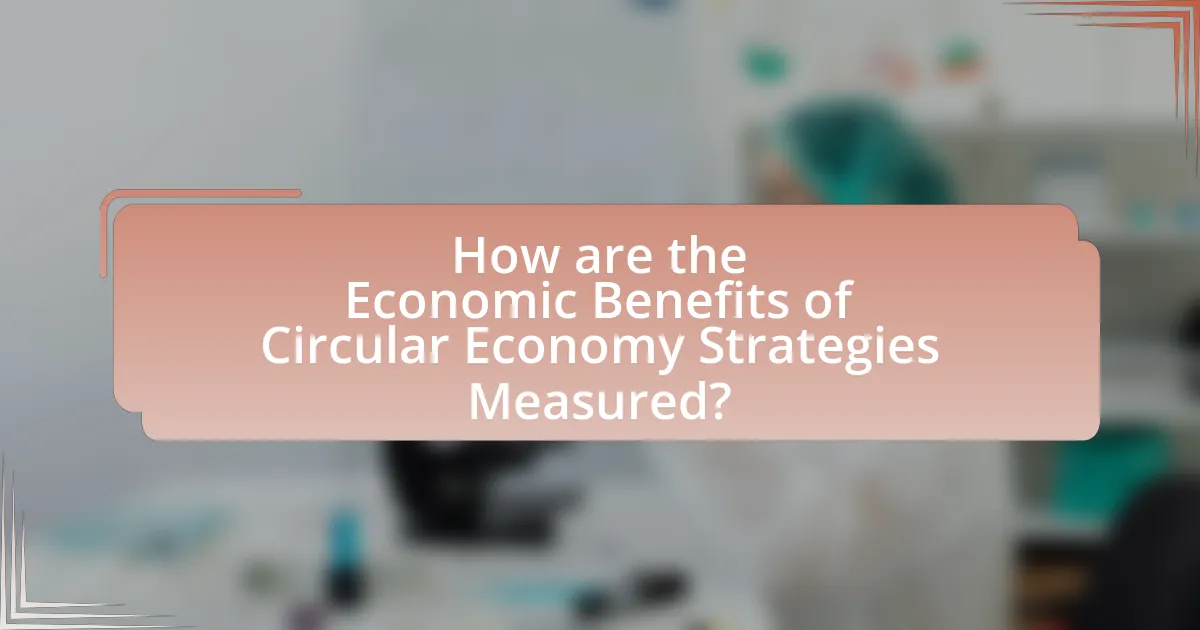
How are the Economic Benefits of Circular Economy Strategies Measured?
The economic benefits of circular economy strategies are measured through various quantitative and qualitative metrics, including cost savings, resource efficiency, and job creation. Cost savings are evaluated by analyzing reductions in material and waste disposal costs, while resource efficiency is assessed by measuring the decrease in resource consumption per unit of output. Job creation is quantified by tracking employment growth in sectors focused on recycling, remanufacturing, and sustainable practices. Studies, such as the Ellen MacArthur Foundation’s report, indicate that transitioning to a circular economy could generate $4.5 trillion in economic benefits by 2030, highlighting the substantial financial impact of these strategies.
What metrics are used to evaluate the economic impact of Circular Economy Strategies?
Metrics used to evaluate the economic impact of Circular Economy Strategies include resource productivity, waste reduction rates, job creation, and lifecycle cost analysis. Resource productivity measures the economic output generated per unit of resource input, indicating efficiency improvements. Waste reduction rates quantify the decrease in waste generated, reflecting environmental benefits and cost savings. Job creation metrics assess the number of jobs generated through circular initiatives, highlighting economic growth potential. Lifecycle cost analysis evaluates the total cost of ownership over a product’s lifespan, providing insights into long-term savings and sustainability. These metrics collectively offer a comprehensive view of the economic benefits derived from implementing Circular Economy Strategies.
How do cost savings from resource efficiency influence economic measurements?
Cost savings from resource efficiency positively influence economic measurements by reducing operational costs and increasing profitability. When businesses implement resource-efficient practices, they often experience lower material and energy expenses, which directly enhances their bottom line. For instance, a study by the Ellen MacArthur Foundation found that adopting circular economy principles could generate $1 trillion in economic benefits by 2025 through improved resource efficiency. This reduction in costs can lead to higher gross domestic product (GDP) figures, as businesses reinvest savings into growth and innovation. Additionally, improved resource efficiency can enhance productivity metrics, as companies achieve more output with less input, further contributing to favorable economic indicators.
What is the significance of job creation in measuring economic benefits?
Job creation is a critical indicator of economic benefits as it directly reflects the health and growth of an economy. When new jobs are created, it signifies increased economic activity, higher consumer spending, and improved living standards. For instance, a report by the International Labour Organization in 2021 highlighted that every 1% increase in employment can lead to a 0.5% increase in GDP, demonstrating the direct correlation between job creation and economic growth. Additionally, job creation fosters innovation and productivity, essential components of a thriving circular economy, which aims to minimize waste and maximize resource efficiency. Thus, measuring job creation provides valuable insights into the effectiveness of economic strategies, particularly in the context of sustainable development.
How do different sectors measure the economic benefits of Circular Economy Strategies?
Different sectors measure the economic benefits of Circular Economy Strategies through various metrics such as cost savings, resource efficiency, and revenue generation from recycled materials. For instance, the manufacturing sector often evaluates the reduction in raw material costs and waste disposal expenses, while the retail sector may assess increased sales from sustainable product lines. The construction industry frequently measures benefits through reduced material costs and improved energy efficiency in buildings. According to a report by the Ellen MacArthur Foundation, companies implementing circular practices can achieve cost savings of up to 70% on materials, demonstrating significant economic advantages.
What specific indicators are relevant for the manufacturing sector?
Key indicators relevant for the manufacturing sector include production output, capacity utilization, inventory levels, and labor productivity. Production output measures the total quantity of goods produced, reflecting the sector’s efficiency and economic health. Capacity utilization indicates the extent to which manufacturing capacity is being used, with higher rates suggesting better economic performance. Inventory levels provide insights into supply chain efficiency and demand forecasting, while labor productivity assesses the output per labor hour, highlighting workforce efficiency. These indicators are essential for evaluating the effectiveness of circular economy strategies in manufacturing, as they directly impact resource use and sustainability.
How do service industries assess the economic impact of Circular Economy Strategies?
Service industries assess the economic impact of Circular Economy Strategies primarily through metrics such as cost savings, revenue generation, and resource efficiency improvements. These industries analyze financial data to quantify reductions in waste management costs and increases in customer loyalty due to sustainable practices. For instance, a study by the Ellen MacArthur Foundation highlights that companies adopting circular practices can achieve up to 30% cost savings through improved resource efficiency and waste reduction. Additionally, service industries often utilize life cycle assessments (LCAs) to evaluate the long-term economic benefits of circular strategies, providing a comprehensive view of their financial impact over time.
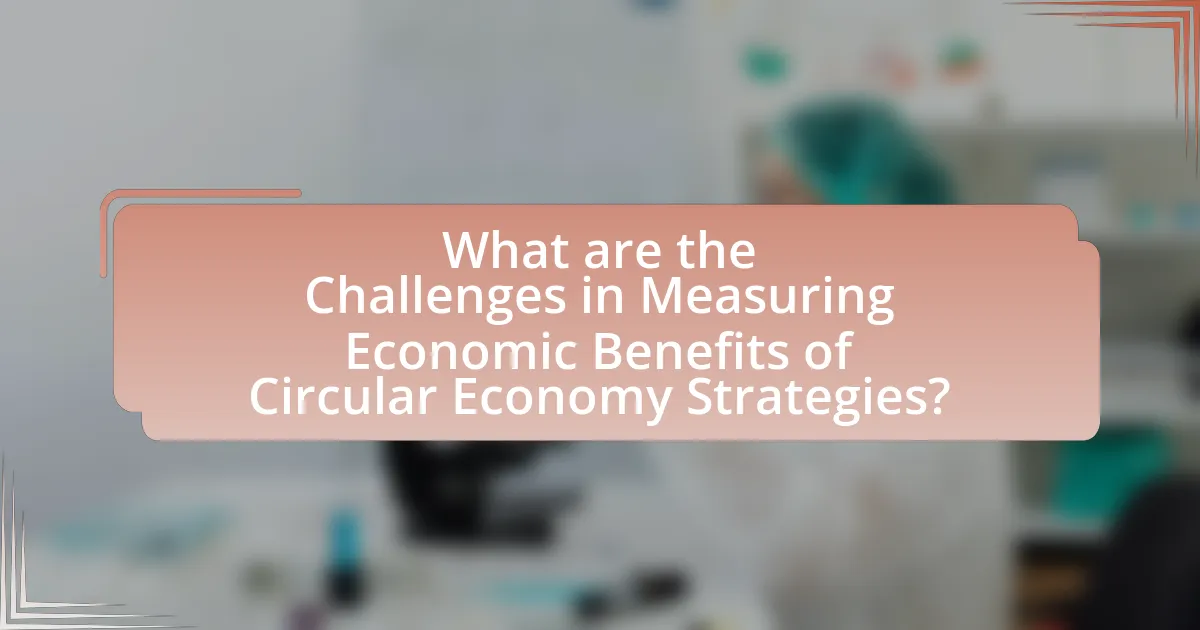
What are the Challenges in Measuring Economic Benefits of Circular Economy Strategies?
The challenges in measuring economic benefits of circular economy strategies include difficulties in quantifying indirect benefits, lack of standardized metrics, and the complexity of data collection. Quantifying indirect benefits, such as environmental improvements and social impacts, is often subjective and varies by context, making it hard to assign a monetary value. Additionally, the absence of standardized metrics across industries complicates comparisons and assessments of circular economy initiatives. Finally, the complexity of data collection arises from the need for comprehensive data across multiple stakeholders and systems, which can be resource-intensive and time-consuming. These factors collectively hinder accurate measurement and evaluation of the economic benefits associated with circular economy strategies.
What obstacles do organizations face in quantifying economic benefits?
Organizations face several obstacles in quantifying economic benefits, primarily due to the complexity of measuring indirect impacts and long-term outcomes. The difficulty arises from the lack of standardized metrics and methodologies for assessing the economic value generated by circular economy strategies. For instance, traditional accounting practices often overlook environmental and social benefits, making it challenging to capture the full scope of economic advantages. Additionally, organizations may struggle with data availability and quality, as reliable data on resource flows and lifecycle impacts is often scarce. This lack of comprehensive data can lead to underestimations or misinterpretations of the economic benefits associated with circular initiatives.
How does data availability affect the measurement process?
Data availability significantly influences the measurement process by determining the accuracy and comprehensiveness of the data collected for analysis. When data is readily available, it allows for more precise calculations and assessments of economic benefits associated with circular economy strategies. For instance, a study by the Ellen MacArthur Foundation highlights that access to robust data sets enables organizations to quantify resource savings and waste reduction effectively, leading to informed decision-making. Conversely, limited data availability can result in incomplete analyses, potentially skewing results and hindering the ability to measure true economic impacts.
What are the limitations of existing measurement frameworks?
Existing measurement frameworks for assessing the economic benefits of circular economy strategies often lack comprehensiveness and adaptability. These frameworks typically focus on quantifiable metrics, such as cost savings and resource efficiency, while neglecting qualitative aspects like social impact and environmental sustainability. For instance, many frameworks do not account for the long-term benefits of circular practices, leading to an incomplete understanding of their overall value. Additionally, existing frameworks may be rigid, failing to accommodate the diverse contexts and industries in which circular economy strategies are implemented, which can result in misleading conclusions. This limitation is evident in studies that highlight the need for more flexible and holistic approaches to measurement, such as the research conducted by Kirchgeorg et al. (2020) in “Measuring Circular Economy: A Systematic Review,” which emphasizes the importance of integrating multiple dimensions of sustainability into measurement practices.
How can organizations overcome challenges in measuring economic benefits?
Organizations can overcome challenges in measuring economic benefits by implementing standardized metrics and frameworks tailored to circular economy strategies. Utilizing established tools like the Circular Economy Indicator System allows organizations to quantify resource efficiency, waste reduction, and overall economic impact. For instance, a study by the Ellen MacArthur Foundation highlights that businesses adopting circular practices can achieve up to 50% reduction in material costs, demonstrating the tangible economic benefits of effective measurement. By integrating these metrics into their operational processes, organizations can better assess and communicate the financial advantages of their circular initiatives.
What best practices can enhance the accuracy of economic measurements?
Best practices that can enhance the accuracy of economic measurements include utilizing standardized methodologies, ensuring comprehensive data collection, and applying robust statistical techniques. Standardized methodologies, such as the System of National Accounts (SNA), provide a consistent framework for measuring economic activity, which enhances comparability and reliability. Comprehensive data collection involves gathering data from diverse sources, including surveys, administrative records, and satellite accounts, to capture the full scope of economic activities, particularly in circular economy contexts. Robust statistical techniques, such as regression analysis and econometric modeling, help in accurately interpreting data and identifying causal relationships. These practices are supported by research indicating that accurate economic measurements are critical for effective policy-making and resource allocation, as evidenced by the European Commission’s guidelines on measuring the circular economy’s impact.
How can collaboration among stakeholders improve measurement efforts?
Collaboration among stakeholders can significantly enhance measurement efforts by integrating diverse perspectives and expertise, leading to more comprehensive data collection and analysis. When stakeholders, such as businesses, government agencies, and non-profit organizations, work together, they can share resources, methodologies, and best practices, which improves the accuracy and reliability of measurements. For instance, a study by the Ellen MacArthur Foundation highlights that collaborative frameworks in circular economy initiatives lead to better tracking of resource flows and economic impacts, thereby providing clearer insights into the benefits of circular strategies. This collective approach not only fosters innovation but also ensures that measurement efforts are aligned with broader sustainability goals, ultimately driving more effective decision-making.
What practical steps can organizations take to effectively measure economic benefits?
Organizations can effectively measure economic benefits by implementing a structured framework that includes defining key performance indicators (KPIs), conducting cost-benefit analyses, and utilizing data analytics tools. Defining KPIs allows organizations to establish specific metrics that align with their economic goals, such as cost savings, revenue generation, and resource efficiency. Conducting cost-benefit analyses enables organizations to compare the costs of implementing circular economy strategies against the anticipated economic benefits, providing a clear financial picture. Utilizing data analytics tools helps organizations gather and analyze relevant data, facilitating informed decision-making and enabling the tracking of economic performance over time. These steps are supported by research indicating that organizations that adopt structured measurement frameworks can achieve up to 20% higher economic returns compared to those that do not.
